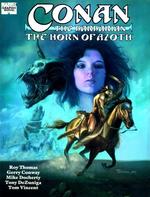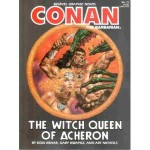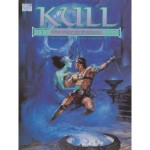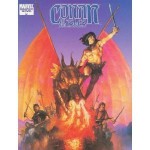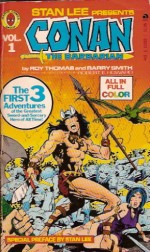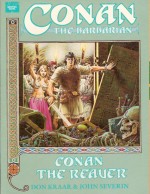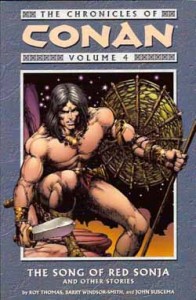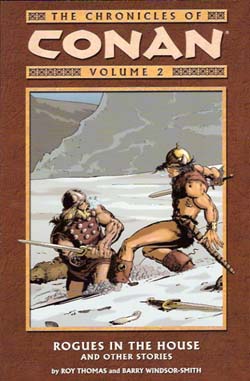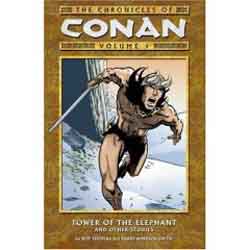– a Marvel Graphic Novel
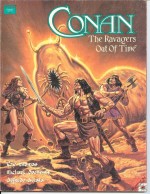
By Roy Thomas, Mike Docherty & Alfredo Alcala (Marvel)
ISBN: 978-0-87135-911-7
During the 1970′s the American comic book industry opened up after more than fifteen years of cautious and calcified publishing practices which had come about as a reaction to the scrupulously-censorious oversight of the self-inflicted Comics Code Authority. The body was created by the publishers themselves to self-police their product and keep it palatable and wholesome after the industry had narrowly survived a McCarthy-style Witch-hunt during the mid-1950s.
One of the first genres to be revisited was Horror/Mystery comics and from that opening up came the pulp masterpiece Conan the Cimmerian.
Pulp-style Sword & Sorcery stories had been undergoing a prose revival in the paperback marketplace since the release of soft-cover editions of Lord of the Rings (first published in 1954) and by the 1960s the revival of the two-fisted fantasies of Edgar Rice Burroughs, Otis Adelbert Kline, Fritz Lieber and others were being supplemented by modern writers such as Michael Moorcock and Lin Carter who kick-started their careers with contemporary versions of man against mage. Undoubtedly the grand master of the genre was Robert E. Howard.
Marvel Comics tested the waters in early 1970 with ‘The Sword and the Sorcerers’ (from horror anthology Chamber of Darkness #4) whose hero Starr the Slayer bore no small resemblance to the Barbarian. It was written by Roy Thomas and drawn by Barry Smith, who was just breaking out of the company’s Kirby house-style.
Despite some early teething problems, including being cancelled and reinstated in the same month, the comic-strip adventures of Robert E. Howard were as big a success as the prose yarns that led the global boom in fantasy and, latterly, the supernatural.
Conan became a huge hit; a giant brand that saw new prose tales, movies, a TV series and cartoon show, a newspaper strip and all the other paraphernalia of success… and it all stemmed from the vast range of quality comics initiated by Thomas and Smith.
In Conan’s all-conquering wake Marvel developed comicbook interpretations of other Howard creations such as Bran Mak Morn, Solomon Kane and others. Undoubtedly the Silver and Bronze medals went to the fairly straight adaptation of King Kull of Atlantis and a rather more broadly reinterpreted Red Sonya of Rogatine.
Roy Thomas was a huge fan of the prose source material and took great pains to adapt the novels and short stories into the graphic canon, but he was also one of the top writers in his field and much of the franchise’s success devolves from his visceral grasp of the characters, which makes this particular graphic novel of particular interest.
All comics fans adore a team-up – especially if the antagonists fight each other as well as whatever menace brought them together – and this dream-ticket event, superbly illustrated by Mike Docherty & Alfredo Alcala, with painted colour from Tom Vincent, combines the big three in a stupendous battle to save the entire Hyborian Age from supernatural Armageddon.
When Conan leads a raid against a Turanian treasure caravan he once more meets friendly foe Red Sonja and an uncomfortably familiar ancient Pict shaman named Gonar who warns them of an old eldritch enemy recently risen from the dead for a third time and destined to become a threat to all who ever lived. After some heated debate the heroes determine to seek out the horror and Conan’s rag-tag bandit army accompany them – less concerned with saving the world than liberating the vast gold mine where Rotath the All-Conquering currently resides…
The sorcerer’s latest form is a hideous confused monster but it still recalls its most recent slayer Conan (see Chronicles of Conan volume 6). The re-resurrected, bewildered and utterly deranged mage wants a human body and when he fails to secure the Cimmerian’s, the gilded nightmare rips open the veil of time and drags Conan and Sonja back eight centuries, where they meet the only other hero ever to have killed Rotath – King Kull.
Determined to wreak final revenge upon all who have ever thwarted him, Rotath employs a legion of intelligent primates dubbed the Ape Lords to attack Kull’s empire of Valusia and blackmails Conan into abducting the King so that the monster can possess his form.
Of course after every mandatory battle of heroes they always unite in common cause and the greatest warriors of two ages are soon making the undying golden wizard rue the day he was reborn…
With brawny battles, warring wizards and enough suspense to choke a mastodon, this action-packed yarn is rip-roaring fantasy fare, brimming with supernatural horrors, wild women, wickedly worldly cynicism and spectacular titanic clashes, cannily recounted by immensely talented creators at the top of their form.
Still readily available, The Ravagers Out of Time is a another magnificently oversized tale produced in the European Album format with large, glossy white pages (285 x 220mm rather than the standard US proportions of 258 x 168mm) which provides another heady swig of untrammelled joy for lovers of the genre and fans of the greatest hero(es) ever to swing a sword or plunder a tomb…
© 1992 Conan Properties, Inc. Conan the Barbarian is a Registered Trademark of Conan Properties Inc. All rights reserved. Kull © 1992 Kull Productions, Inc. Kull and the distinctive likeness thereof is a Trademark of Kull Productions, Inc. All rights reserved. Red Sonja © 1992 Red Sonja Corporation. Red Sonja and the distinctive likeness thereof is a Trademark of Red Sonja Corporation. All rights reserved.

